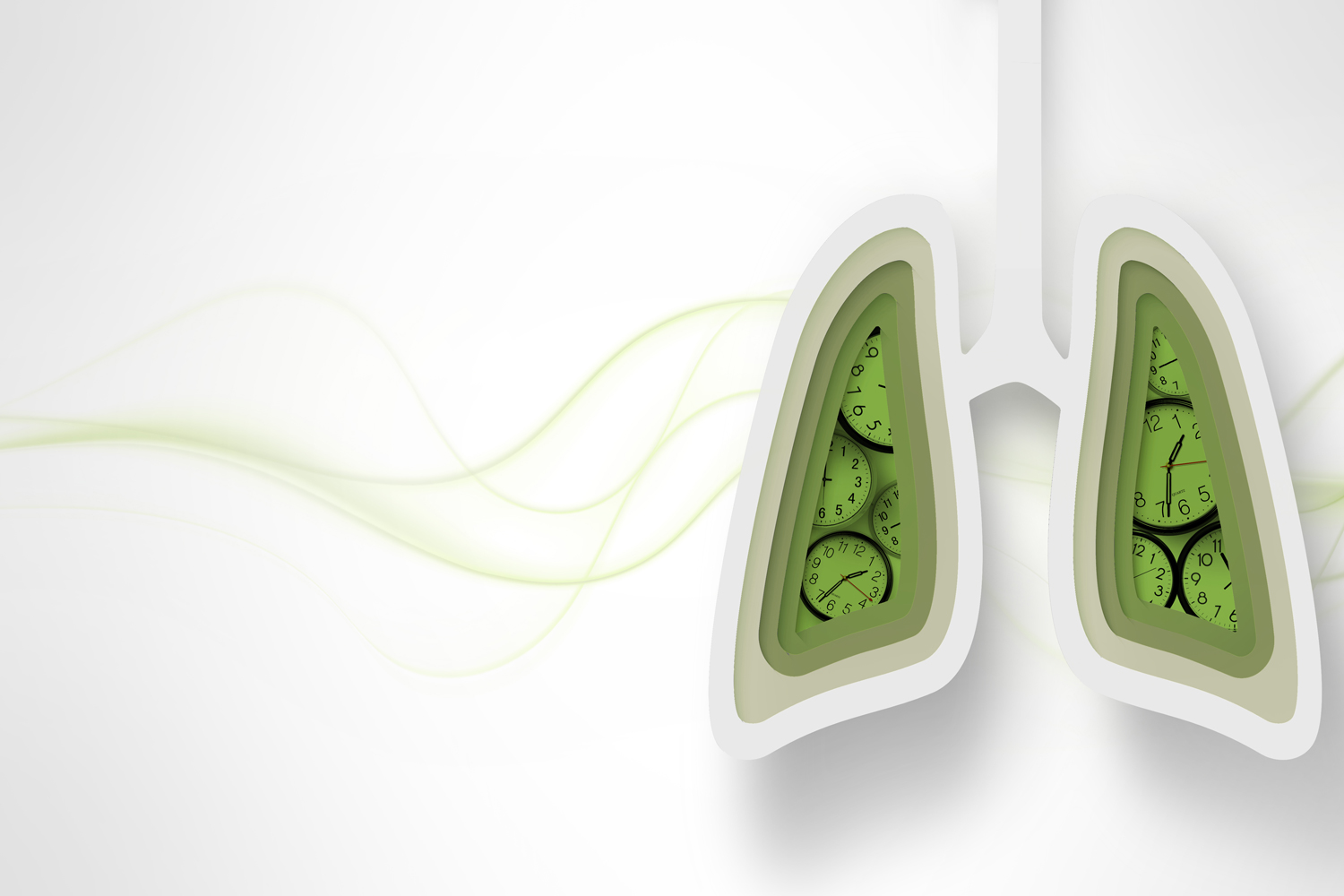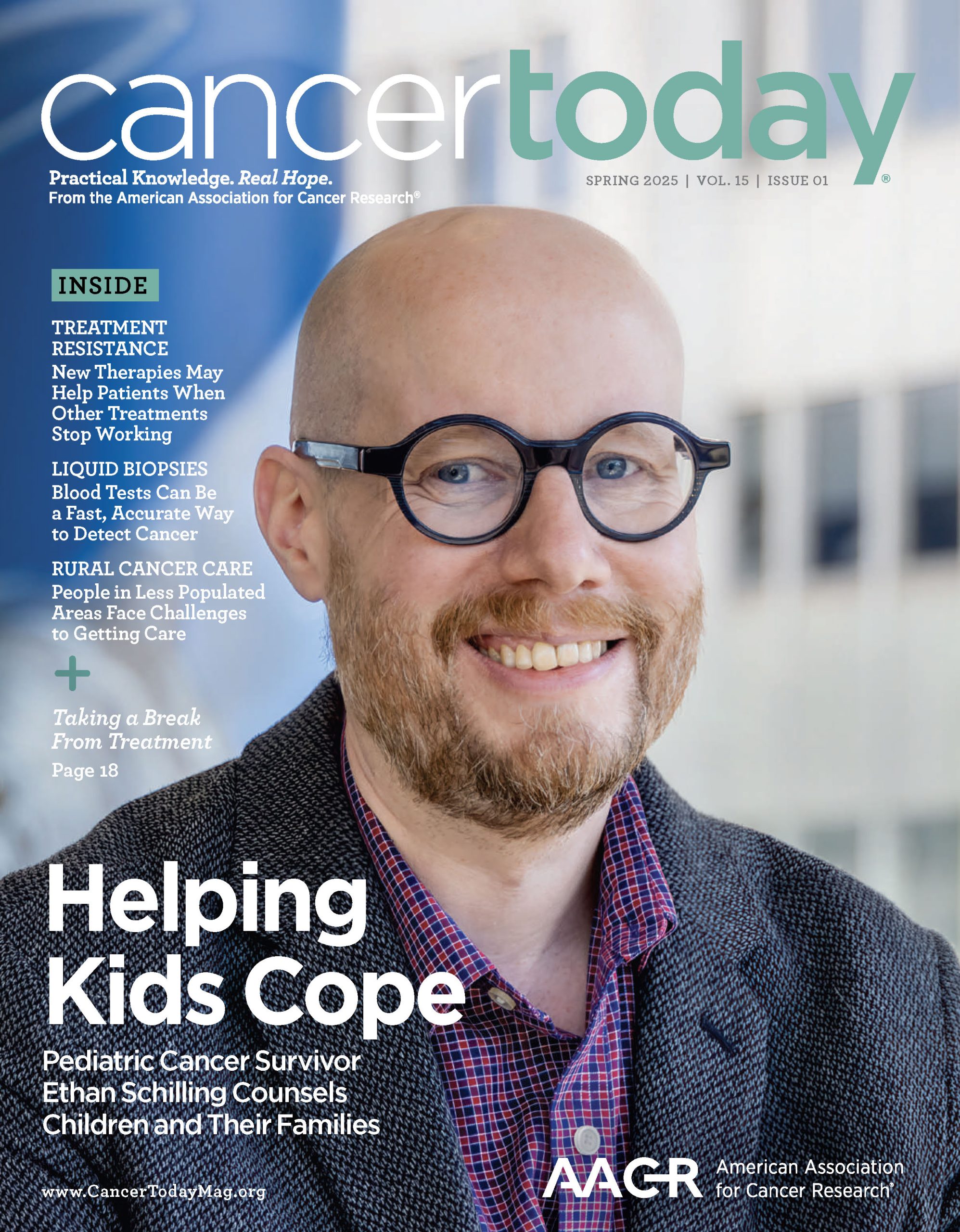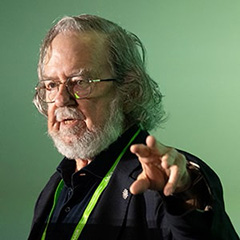IN DECEMBER 2022, JOY MOUSSEAU, a bookkeeper in Taylor, Michigan, saw her doctor for stomach pain. After an ultrasound and an abdominal MRI failed to identify the problem and an appendectomy failed to remove the source of her pain, a colonoscopy uncovered a large blockage in her colon. The mass turned out to be cancerous. Mousseau, then 60, had surgery right away to remove the tumor, but because colon cancer can frequently spread to the lungs, her doctor ordered a chest X-ray.
It turned out that Mousseau did indeed have a mass in her lung, but it was not a metastasis from her colon cancer. The cancer in her lung was a totally unrelated tumor. Mousseau was diagnosed with stage II non-small cell lung cancer (NSCLC) in March 2023. In a way, she was fortunate. Without the chest X-ray and MRI, her lung cancer could have progressed unnoticed. “I had no symptoms whatsoever,” Mousseau says. “I didn’t have a cough, I wasn’t fatigued, no shortness of breath, no rapid heartbeat. None of it.”
In fact, about half of NSCLC diagnoses come when the cancer has already spread to distant parts of the body. The five-year relative survival rate for these people is only about 9%. At earlier stages, when the cancer is still limited to the area of the body where it started, the five-year relative survival rate for NSCLC is about 65%.
Still, even people who receive an early-stage NSCLC diagnosis and have treatment that leads to a remission have a high risk of recurrence and metastasis, says medical oncologist Hirva Mamdani at Karmanos Cancer Institute in Detroit, who is treating Mousseau. Some data show that as many as 30% to 55% of early-stage NSCLC patients will see their cancer come back even after they’ve had surgery.
Expanding Immunotherapy’s Benefit to Early-stage Disease
Enter immunotherapy. Immunotherapy treatments—specifically drugs called immune checkpoint inhibitors (ICIs)—have emerged as an important addition to the toolbox to treat NSCLC. ICIs like Tecentriq (atezolizumab), Opdivo (nivolumab), Keytruda (pembrolizumab) and Imfinzi (durvalumab) work by giving the immune system a boost to fight and kill cancer cells.
In lung cancer, ICIs were initially used for advanced-stage NSCLC. But now, more studies are showing ICIs could extend remission when used before or after surgery in stage II and III NSCLC.
Over the past few years, several clinical trials have shown that certain ICIs improved measures of disease-free survival and, in the case of Keytruda, overall survival in stage II and III NSCLC patients, leading the Food and Drug Administration to expand the approval of these drugs for early-stage NSCLC. As of April 2024, there were three ICIs approved to treat resectable stage II and III NSCLC: Opdivo can be given before surgery, Tecentriq can be given after surgery, and Keytruda is approved for both.
ICIs can help people live longer without their disease coming back. For example, in a trial presented at the European Society for Medical Oncology Congress in October 2023, Opdivo given with chemotherapy before surgery—called a neoadjuvant approach—along with Opdivo given after surgery increased disease-free survival in stage III NSCLC patients to 30 months, compared with 13 months for patients who had chemotherapy alone. In another trial published Aug. 10, 2023, in the New England Journal of Medicine, 62% of people with stage II to IIIB NSCLC who received Keytruda with chemotherapy before surgery and again by itself after surgery survived for two years without disease recurrence, compared with 41% of those who received chemotherapy with a placebo.
While survival can take years to measure, the benefits of ICIs can sometimes be apparent right away. Studies show that neoadjuvant treatment that results in a pathologic complete response, meaning all the cancer cells appear to be gone, can significantly improve overall survival and extend the time it takes for cancer to come back. With neoadjuvant chemotherapy alone, at best, about 5% of patients achieve this level of response, says Lei Deng, a thoracic medical oncologist at Fred Hutchinson Cancer Center and the University of Washington Medical Center in Seattle.
Eighteen percent of patients who received Keytruda before and after surgery in the August 2023 trial had a pathologic complete response compared with just 4% of patients in the placebo group. In the October 2023 trial on Opdivo, 25% of patients who received chemo-immunotherapy had a pathologic complete response, compared with 5% of patients in the study given chemotherapy alone. Results published Nov. 2, 2023, in the New England Journal of Medicine showed that in patients given Imfinzi plus chemotherapy, followed by Imfinzi after surgery, the pathologic complete response rate improved to 17%, up from 4% in patients who received chemotherapy with a placebo.
‘When Can We Start?’
ICIs are not a good fit for every patient. In most cases, the best candidates are people whose tumor expresses high levels of the biomarker PD-L1 because most ICIs specifically target either this protein or its receptor protein, PD-1. In cancer centers, it is standard practice for someone with an NSCLC diagnosis to get a molecular test of their tumor to better understand their cancer’s genetic makeup, including their PD-L1 levels. When Mamdani got Mousseau’s blood work back, her PD-L1 levels were a whopping 95.5%, meaning almost all of the cells in her tumor expressed this protein. “She said these were the highest markers they’d ever gotten back,” Mousseau recalls. “They gave me a lot of brochures to read, but why would I not do it? As soon as I heard 95.5%, I asked her, ‘When can we start?’”
PD-L1 levels in the tumors of NSCLC patients vary widely. While PD-1 inhibitors Opdivo and Keytruda are approved for treatment in earlier-stage resectable NSCLC regardless of a patient’s PD-L1 results, PD-L1 inhibitor Tecentriq requires a PD-L1 test, and patients must have at least 1% expression to receive the treatment.
In studies that combined ICIs with chemotherapy before surgery, people whose tumors expressed high levels of PD-L1 had the best results. Still, those tumors that had low PD-L1 expression also seemed to respond when treated with the ICI plus chemotherapy compared with chemotherapy alone. “As a single agent, [neoadjuvant immunotherapy is] not so good for PD-L1 negative tumors. But when you combine it with chemo, there does appear to be synergistic activity between the immune checkpoint inhibitor and the chemotherapy,” says Mamdani. She recommends adjuvant immunotherapy, treatment after surgery, only for patients whose tumor expresses high levels of PD-L1. “For [patients with PD-L1 levels less than 1%], I discuss [adjuvant immunotherapy], but I don’t recommend it,” she says.
Genetic mutations are another key factor in deciding whether to use ICIs. In addition to measuring for PD-L1, tumor molecular analysis can measure for certain “driver mutations,” which are the primary driving force behind a person’s cancer. Two commonly mutated genes in NSCLC are EGFR and ALK. “It’s very important that the tumor is negative for EGFR and ALK before we decide to give immunotherapy in early-stage settings,” says Mamdani. “Immune checkpoint inhibitors just don’t work well for these tumors.” This is true even for patients with these mutations who have very high PD-L1 expression, she adds.
Mousseau’s tumor was negative for both EGFR and ALK, giving her the green light for immunotherapy. After having surgery in May 2023 to remove the tumor and the lower half of her left lung, she had four rounds of chemotherapy. She began taking Tecentriq in October 2023 and will continue receiving infusions every three weeks for a year.
Timing It Right
Choosing the optimal time to administer ICIs alongside surgery for early-stage NSCLC is still an open question. “Unfortunately, right now, we don’t know which is better [overall],” says Deng, about whether patients who receive ICIs before, after, or both before and after surgery will have better outcomes. “Sometimes it comes down to the patient’s preference.”
Neoadjuvant immunotherapy has many advantages. The very presence of an immunologically “hot” tumor can make ICIs more effective by giving them a better target. “When you have the entire tumor and potentially the lymph nodes in place in the body, the stimulation of the immune system is way more than what you can achieve postoperatively after the tumor is out,” says Mamdani. “The tumor is kind of acting as the fuel for the fire of immunotherapy.”
However, neoadjuvant immunotherapy takes time, delivered in courses over nine to 12 weeks. If the immunotherapy is not effective or if a cancer is particularly aggressive, a delay like this can give time for tumors to grow, which could be dangerous for the patient and potentially cause the patient to be ineligible for surgery. “Not being able to go for curative-intent surgery is the biggest fear when we are committing patients to something that puts a distance between their diagnosis and surgical resection,” Mamdani says. Some patients may experience side effects and may not be in good enough physical shape to undergo surgery. Side effects from immunotherapy might include tiredness and gastrointestinal issues. Some effects can continue after treatment stops, including inflammation or thyroid problems. Inflammation and thyroid problems can also begin up to three months after immunotherapy treatment ends, says Mamdani. People will likely also have side effects from chemotherapy if they’re doing a combined treatment.
When people with no history of smoking get lung cancer, it’s often driven by gene mutations that make it less likely to respond to immunotherapy.
The number of people who die from non-small cell lung cancer (NSCLC) annually has declined in recent decades, partly due to people cutting down on smoking. Still, 10% to 20% of those who are diagnosed with lung cancer in the U.S. are people who have never smoked or smoked very little. Nonsmokers are more likely to have lung cancer that doesn’t respond to immunotherapy. These cancers are typically fueled by driver mutations and respond to targeted therapies that inhibit those specific genes.
The most commonly occurring driver mutation in nonsmokers with lung cancer occurs in the EGFR gene. This can be thought of as a switch for turning cell growth on and off, explains Hirva Mamdani, a medical oncologist at Karmanos Cancer Institute in Detroit. An estimated 10% to 15% of lung cancers in the U.S. carry EGFR mutations—particularly those in women, younger people and people of Asian descent. Some data show EGFR is mutated in about a third of stage II and III NSCLCs. The prevalence of EGFR mutations can be twice as high in nonsmokers as in smokers.
Another gene, ALK, sometimes fuses with other partner genes and leads to uncontrolled cell replication. ALK rearrangements are present in about 12% of never-smokers diagnosed with NSCLC, compared with just 2% of current or former smokers.
Immunotherapy does not work very well for these tumors. Instead, these cancers are treated with targeted therapies such as the EGFR inhibitor Tagrisso (osimertinib) or the ALK inhibitor Alecensa (alectinib). The vast majority of lung cancers in patients who have never smoked can be treated using Food and Drug Administration-approved targeted drugs. Although targeted therapies come with their own challenges and side effects, they can significantly improve disease-free and overall survival in people with NSCLC with these driver mutations.
On the other hand, some patients end up not being able to receive or complete adjuvant immunotherapy, either because they haven’t recovered adequately from surgery or because the side effects keep them from completing a full year of treatment. Older patients may not have the help they need to keep up with their appointments through a yearlong treatment course. Neoadjuvant therapy ensures that patients get at least some benefit from immunotherapy before the more physically challenging phase of treatment ramps up.
“Neoadjuvant is only three or four cycles. We’re talking only nine to 12 weeks. So it’s much easier to commit to that [than a year of adjuvant therapy],” Mamdani says.
Challenges of a Changing Landscape
As more options become available to treat NSCLC, Mamdani stresses that patients should seek a multi-disciplinary team of experts to help them make decisions. Mousseau initially received care for both of her cancers at a nearby hospital, where doctors suggested she have surgery to remove her entire left lung, possibly with chemotherapy first. When she sought a second opinion at Karmanos, a National Cancer Institute-designated comprehensive cancer center, Mamdani and her team came up with a more tailored plan that would spare more of Mousseau’s lung and reduce the amount of chemotherapy she would need.
Mamdani recalls another patient who came to her seeking a second opinion. The patient was told by their oncologist that doctors “never” do surgery for people with stage III NSCLC, so the oncologist recommended chemoradiotherapy and immunotherapy. Notably, for reasons that are unclear, the patient did not receive biomarker testing to understand the cancer’s genetic makeup, Mamdani says.
Deng explains that cancer centers use interdisciplinary tumor boards, which comprise a team of medical oncologists, radiation oncologists, radiologists, pathologists and surgeons working closely together to discuss best approaches for individual patients. At local hospitals, where oncologists see large numbers of patients with different kinds of cancers, this kind of collaboration can be difficult to manage, says Deng, but closer cooperation between surgeons and oncologists is critical for these hospitals to better treat their patients.
When patients feel empowered to step up as active partners in their own care, they can play a key role in improving their outcomes. “Joy has been one of those people who knew what they wanted to do, even before coming to the clinic,” says Mamdani about Mousseau.
At her six-month follow-up in April 2024, Mousseau’s lungs looked clear. She has tolerated her immunotherapy without side effects, she says, and despite her battle scars, she feels almost as good as new. “I feel back to normal—back to where I was even before any of this started,” she says.
Cancer Today magazine is free to cancer patients, survivors and caregivers who live in the U.S. Subscribe here to receive four issues per year.





